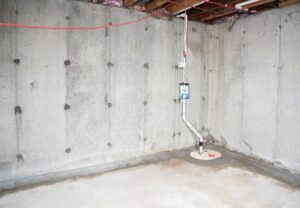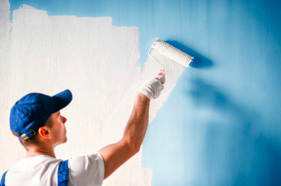Kitchen Cabinet Painting Naperville IL includes preventing moisture intrusion and repairing structural problems in your home’s basement. It also involves insulating the area and protecting interior walls from moisture damage.
Small cracks in basement walls, water intrusion, or a wet basement can all indicate major problems. Often, these problems are addressed by a system that consists of drain tile, French drains, and a sump pump.

Many homeowners ignore cracks in their basement walls, thinking they aren’t a serious problem or will “get better.” But these cracks allow water to seep into the basement, increasing humidity and creating an ideal environment for mold. The resulting unhealthy air will eventually enter the rest of the home.
A variety of methods can repair cracks in basement concrete. Some of these methods rehab the appearance of the cracked wall and help prevent moisture infiltration, while others improve the structural integrity of the concrete itself. In addition, some can be adapted to address underlying issues that cause the cracks.
Some cracks in basement walls are caused by hydrostatic pressure on the foundation. Water in the soil can weigh up to 60 pounds per cubic foot, which puts a lot of force on basement walls. Accumulated water can also erode the sides of basement walls, widening the crack and weakening the foundation.
One method for repairing these types of basement cracks is to use a specialized crack sealant. This is a do-it-yourself-friendly approach that can treat cracks less than an inch wide. The crack sealant is injected into the cracked basement wall through plastic injection ports. The epoxy injected into the basement cracks can help bond the concrete and block water from seeping through the wall.
Another option for treating these cracks is to use a patented crack-sealing system called FlexiSpan. This is a do-it-yourself system that can be used to treat both non-structural and structural basement cracks. The FlexiSpan system is designed to provide two lines of defense against leaking basement walls: a crack sealant and a hidden, low-profile drainage channel that directs leaking water to the sump pump. The flexible nature of FlexiSpan allows the channel to flex with the movement of the basement walls, helping to ensure that no water leaks through the cracks.
Other causes of basement cracks include differential settlement of the house’s foundation. This occurs when parts of the foundation settle at different rates, causing the concrete walls to crack as they move. Some cracks in basement walls are more serious than others, indicating the presence of an underground soil issue that needs to be addressed. Your Acculevel project advisor can recommend engineered foundation repair solutions that deal with these kinds of soil issues, helping to prevent future cracks and bowing in the basement walls.
Basements are susceptible to leaks, including the joints between the walls and footing, the sill, and the joints where new extensions are built. These joints need to be watertight to prevent further damage and water penetration. Hydraulic cement can be used to patch and fill these joints, helping to prevent future water leaks and repair existing ones.
Exterior waterproofing is a great way to stop water leaks before they even enter your home, preventing the need for interior wall repairs. This process involves excavating and exposing the foundation, then installing a waterproofing system with drain tile surrounded by rock and a filter fabric next to the footing. The water accumulating in the area is redirected to a downspout or sump pump. The area is then backfilled with native soil and tamped down. Finally, any landscaping that was moved to be done during the excavation is replaced, and the area is cleaned.
Many companies offer Band-Aid solutions for waterproofing a basement without digging up the foundation, such as waterproof paints and coatings. However, these products don’t seal the pores of concrete walls and, therefore, do not stop water from entering the basement under hydrostatic pressure.
Tar coating is a popular option, but it does not keep water out for long. It takes four to eight hours for a coat of tar to dry, and fluctuations in temperature can affect its effectiveness. It also releases toxic fumes during the application process, so it is a job best left to the professionals.
Having a waterproof basement is a critical step in protecting your home from mold and mildew, which can lead to structural problems and health issues for your family. Suppose you have noticed moisture seepage in your basement walls. We can recommend the right solution for your home and give you peace of mind that your basement will be safe from moisture for years.
Bowed and leaning walls are signs of serious basement damage that should never be ignored. They indicate that your foundation is under intense pressure from the outside. If left untreated, the bowing and leaning walls will continue to worsen and can cause severe structural damage throughout your home or commercial property.
While it’s common to have minor cracks in your basement walls from time to time, any significant bulging or buckling should be examined by a professional right away. The reason for this is that if the cracks in your basement wall are vertical, horizontal, or at a 45-degree angle, they may indicate structural damage to the wall itself or the foundation. If this is the case, you’ll need to have a concrete repair contractor look at your home or business immediately to ensure the structure is safe and secure for all occupants.
The most common cause of basement wall problems is excessive lateral pressure from the soil around your foundation, caused by poor drainage, water intrusion, and damaged waterproofing. This type of pressure is known as hydrostatic pressure and can cause your brick, block, or concrete foundation walls to shift, sink, or bow. While this can happen naturally, it’s possible to speed up the process if your basement needs well-maintained or adequate waterproofing and drainage systems installed.
In addition to the bowing and leaning walls, you may also notice that your basement stairways pull away from the wall. This is another sign of hydrostatic pressure and can be repaired with helical tieback anchors. These are installed in the ground and connected to a plate inside the wall that tightens over time, helping to straighten the walls.
In addition to helical tieback anchors, you can use carbon fiber strapping to seal and strengthen your basement walls. This is especially effective for repairing cracks in the corners of your basement and keeping them from getting any larger. This product is installed in the ground around your basement with a top bracket that ties to the joists of your foundation for an ultra-secure connection.
Floor cracks aren’t as common as wall cracks but should be inspected and repaired as part of any basement repair project. These cracks are most often caused by soil movement. This shifting of the ground under your home can cause a cracking in your floor that worsens over time.
If you have a few hairline cracks in your basement floor, these are normal and do not indicate a bigger problem. However, any cracks wider than 1/8 of an inch should be sealed to keep water, moisture, soil smells, and radon gas from seeping through the floor. Cracks that are more pronounced and extend from the perimeter of your home to the interior walls may be a sign of a foundation shift that can lead to serious problems like leaks and collapse.
Uneven concrete floors should also be looked at, and if they are sinking, you may need to do something as simple as filling the void with expanding polyurethane foam. Alternatively, a solution called PolyLevel can lift and stabilize a sinking concrete slab permanently by drilling penny-sized holes into the slab and then injecting a high-density polyurethane formula that expands under the floor to lift it.
While concrete is an incredibly strong and durable building material, it can still crack over time due to changes in the environment and soil underneath your home. Depending on their size and severity, these cracks should be fixed to prevent future damage and to maintain your home’s value. If you notice a cracking in your floor or other signs of a foundation issue, contact a reputable basement repair company to assess the situation and determine the best course of action.



